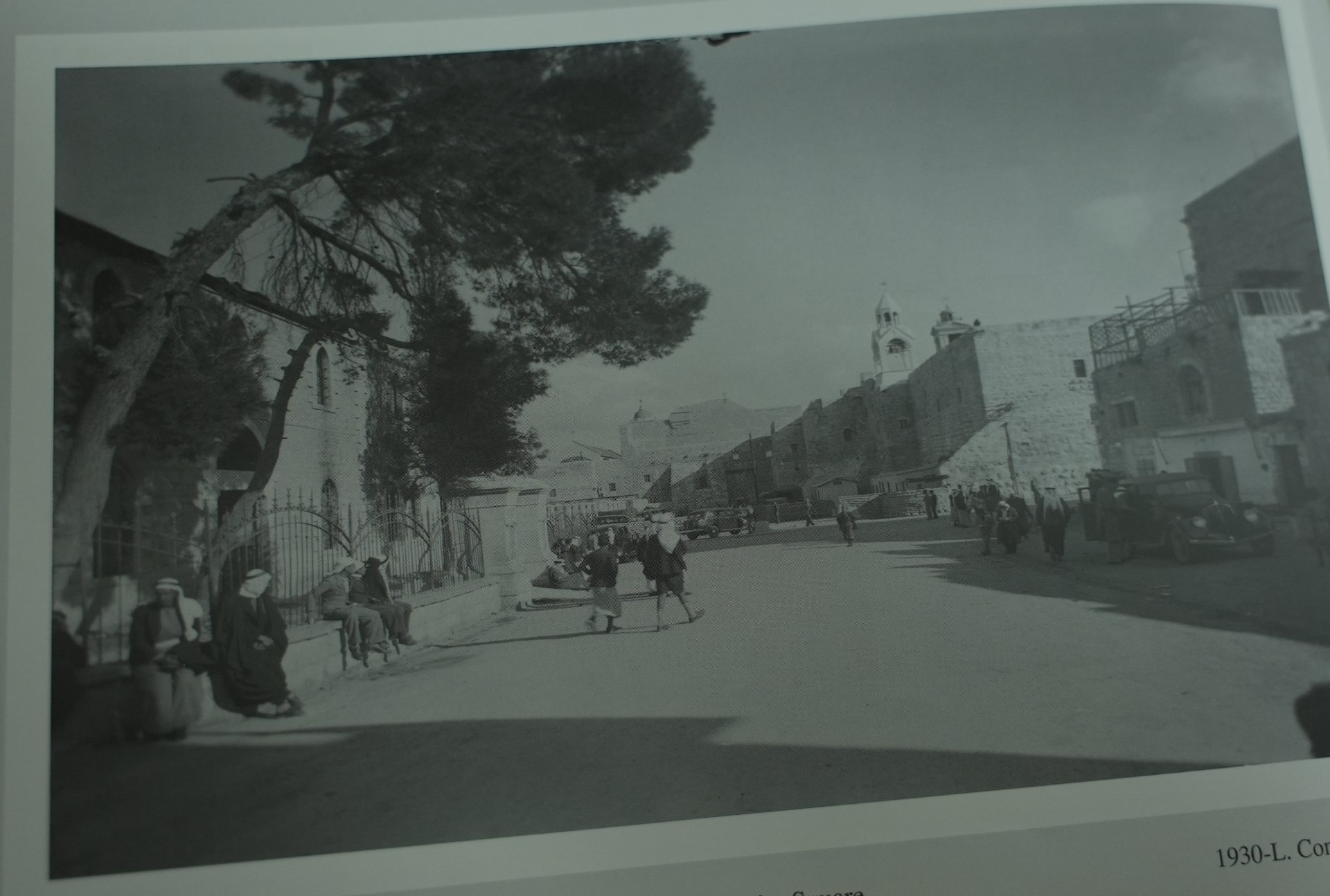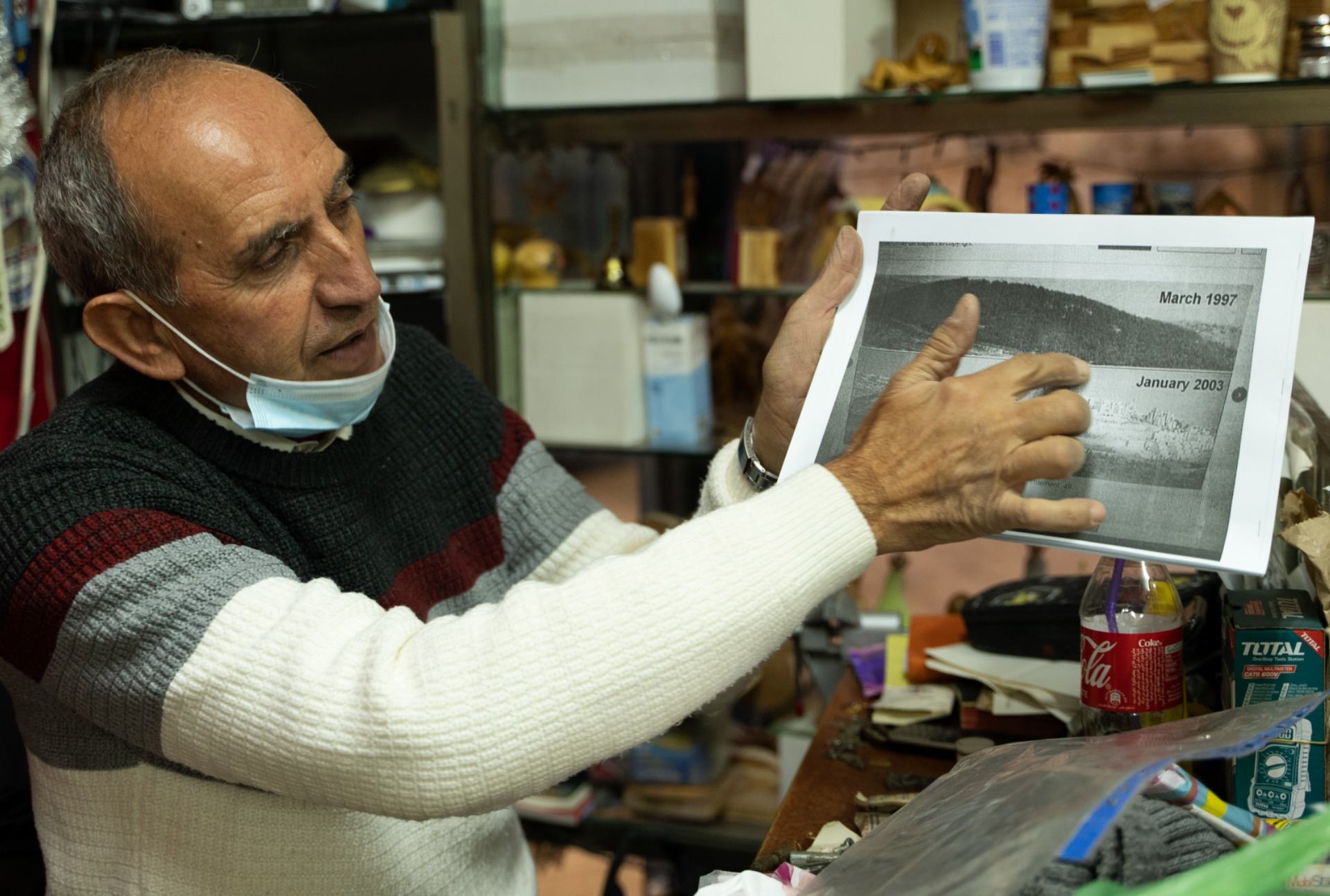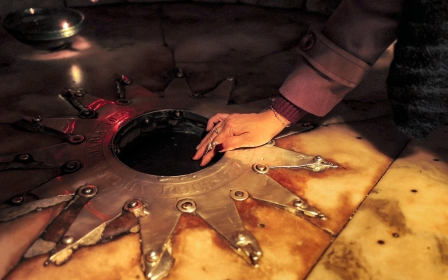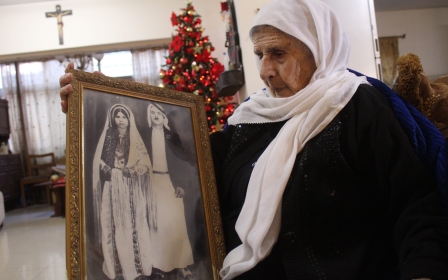Christmas in Bethlehem: From 'days of wonder' to a plastic tree

Nowadays the 12-metre tall Christmas tree in Bethlehem's Manger Square, like most of the festive decorations across towns and villages in the Palestinian West Bank, is made of plastic.
But Fawz Atallah Qumsiyeh remembers going as a child with her father to Jabal Abu-Ghneim, a once-forested mountaintop southeast of Jerusalem that is now the site of an Israeli settlement, in search of a suitable branch of a cypress tree to adorn the family home.
“Christmas used to have a different kind of cheer, and finding a tree was a part of the celebration,” Qumsiyeh, a 90-year-old former teacher, told Middle East Eye.
“My father used to go into the wilderness, and we would go with him, and we would cut off the branch of a small pine tree. We would never cut a whole one."
New MEE newsletter: Jerusalem Dispatch
Sign up to get the latest insights and analysis on Israel-Palestine, alongside Turkey Unpacked and other MEE newsletters
Qumsiyeh is still sharp-eyed and animated as she remembers Christmases past at her home in Beit Sahour. She has spent much of her long life in the small town southeast of Bethlehem where, in the Christian tradition, angels are said to have visited shepherds to announce the birth of Jesus.
Growing up in British-ruled Palestine in the 1940s, Qumsiyeh recalls how she and her siblings would make hand-crafted decorations to hang on the tree, as well as bags of gifts for other children in their neighbourhood, such as marbles, clementines, and a home-baked cake made with walnuts and almonds.
No electricity, no lights
“At the time there was neither electricity nor Christmas lights, so we made all decorations by hand,” she said.
“We’d colour leaves, make figures resembling flowers and fish, cut paper into shapes, and hang them on the trees.
“Beit Sahour was poor then, and there weren’t any toy stores. But my dad, who was the school principal, was well-off, and he would drive to Jerusalem and fill his car with toys and come back and give them to everyone. My father was an orphan as a child, and it was important for him."
Born in 1932, Qumsiyeh finished high school in 1948 and enrolled at a teacher training college for women in Jerusalem.
But her career was immediately disrupted by the 1948 war, the events the Palestinians call the Nakba, which involved the dispossession and banishment of hundreds of thousands of Palestinians by Jewish paramilitary forces and led to the creation of the state of Israel.
The training college was in an area now within Israel's borders which became notorious as the site of an interrogation centre and prison for Palestinians known as the Maskobiyeh.
“All the schools were closed, and were only reopened in 1950 when I started to teach at an orphan’s school," said Qumsiyeh.
Two years later, she moved to a school in Bethlehem, and then, after marrying, she returned to Beit Sahour, following in her father's footsteps as a school principal.
"Even then the trees were still natural, and they would be sold on the backs of trucks that would be brought in from inside 48 [the lands of historic Palestine now inside Israel]," she said.
"Now there’s a settlement in Abu Ghneim, and all our trees are plastic brought in from China, tasteless and scentless. Nothing really makes up for the smell of the natural ones."
'Beautiful days'
Maurice Michel, 87, remembers there was once a real pine tree in Manger Square, planted alongside a police station that stood there during the British Mandate on the site of what is now the Bethlehem Peace Center, that was decorated each Christmas.
A retired - but still active - photographer, Michel is talking in his studio, surrounded by carefully organised vintage equipment, cine reels, projectors, and trays of slides that are a testament to his life's passion.
He shows MEE a box camera used by his father who died when he was six months old. Then he digs out a print dated 1930 from his files showing the tree leaning towards the bell tower of the Church of the Nativity.
“The tree stayed for a long time, and people would go to get photographed in front of it because of the decorations that adorned it. Even the Jordanian army would play instruments by the tree,” he said, referring to the period between 1948 and 1967 when the West Bank was under Jordanian control.
“Those were beautiful days. People would bring pine trees into their homes and decorate them. Christmas was nicer and simpler then, and we really felt the holiday and anticipated it eagerly.”
The tree was uprooted when the police station was demolished. There are still a few trees around Manger Square, including a tall pine outside the Peace Center, but none are now decorated at Christmas.
Pagan tradition
According to Mazin Qumsiyeh, a professor at Bethlehem University and the founder and director of the Palestine Museum of Natural History, the modern custom among Palestinian Christians of decorating trees at Christmas was a direct consequence of British colonial rule until 1948.
He points out that the European tradition of Christmas trees can be traced back to pre-Christian pagan festivals when pine trees were used to mark the winter solstice.
“The British imposed these Western and capitalist traditions on us. There were no decorations before that, and Christmas was considered a solely religious holiday,” said Qumsiyeh, who is the son of Fawz Atallah Qumsiyeh.
“The custom of giving presents to the poor, however, was present from before the British Mandate. My father would travel to Damascus and Beirut in preparation for Christmas. Today we can't even reach Jerusalem. Even then, however, the presents were modest, and they weren’t toys like today.”
In a gift shop in Bethlehem, Louis Michel points to a photocopied piece of paper showing two black and white photos of Jabal Abu-Ghneim.
In the first, dated 1997, the East Jerusalem hilltop is densely forested. Many of the trees were planted under British rule as part of a policy of forestation which has seen colonies of European pine trees replace native species such as olive trees and grapevines, transforming the natural landscape and traditionally terraced agricultural lands of historic Palestine.
Israel has continued to plant the trees, which have grown over the ruins of Palestinian villages and farms demolished since 1948. The highly flammable trees have been linked to recent forest fires across Israel and Palestine.
In the second photo, dated 2003, all the trees are gone, replaced by the white houses and apartment blocks of the still expanding Har Homa settlement. Like all Israeli settlements in occupied East Jerusalem and the West Bank, Har Homa is illegal under international law.
“There were so many cypress and pine trees. Abu-Ghneim boasted some of the most beautiful trees in the area, and they were so big it was frightening,” said Michel, who is 61.
“Before 1967, we could walk by the side of the hill all the way to Damascus Gate in Jerusalem. Then after the Second Intifada, they cut down the trees and built the Har Homa settlement there.”
'The magic is gone'
Michel’s shop has been a family business since 1918. He recalls spending Christmas time growing up there when his father ran it in the 1960s, selling souvenirs to Christian tourists.
“I still remember those days of wonder. Today the magic is gone, and people just come to take selfies in front of a plastic tree,” he said, holding up a string of Chinese-made plastic rosary beads.
“This costs nine shekels, so people started buying them instead of local beads made of olive wood which cost 35 shekels. Opening the market to China has devastated local production.”
Michel’s words are echoed by Eli Shehadeh, a former mayor of Beit Jala, a small town northwest of Bethlehem.
“The Beit Jala Christmas tree is artificial, and from my experience doing municipal work, there isn’t a single real tree in the entire West Bank,” said Shehadeh.
“The Greek Orthodox Church used to have a natural pine tree that was decorated annually but that died about years ago. Now all of the trees are from China; Chinese plastic has occupied the country.”
This article is available in French on Middle East Eye French edition.
Middle East Eye delivers independent and unrivalled coverage and analysis of the Middle East, North Africa and beyond. To learn more about republishing this content and the associated fees, please fill out this form. More about MEE can be found here.








